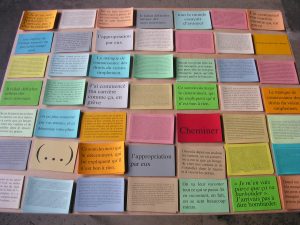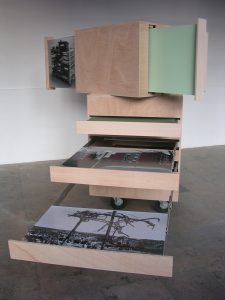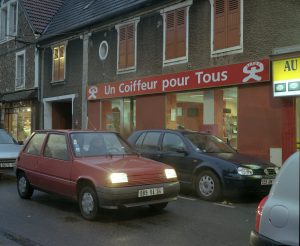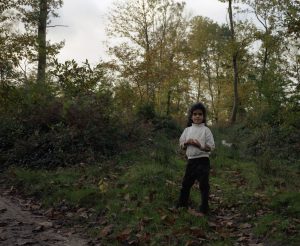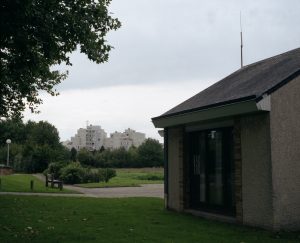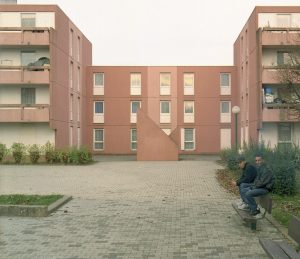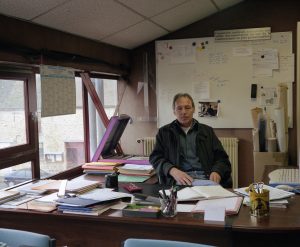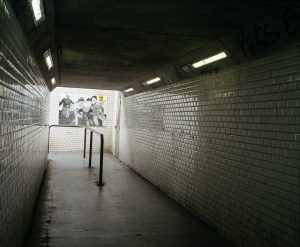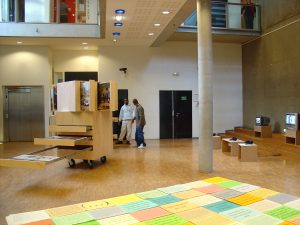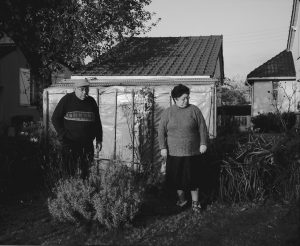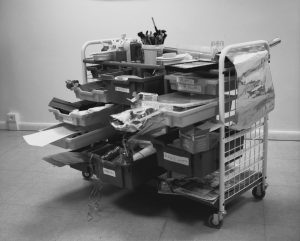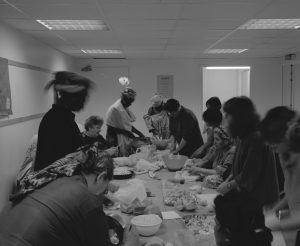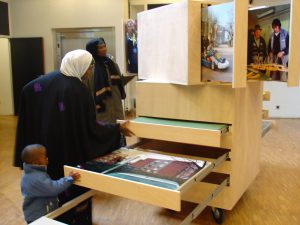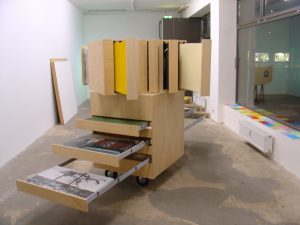Trappes, Ville Nouvelle
(37)
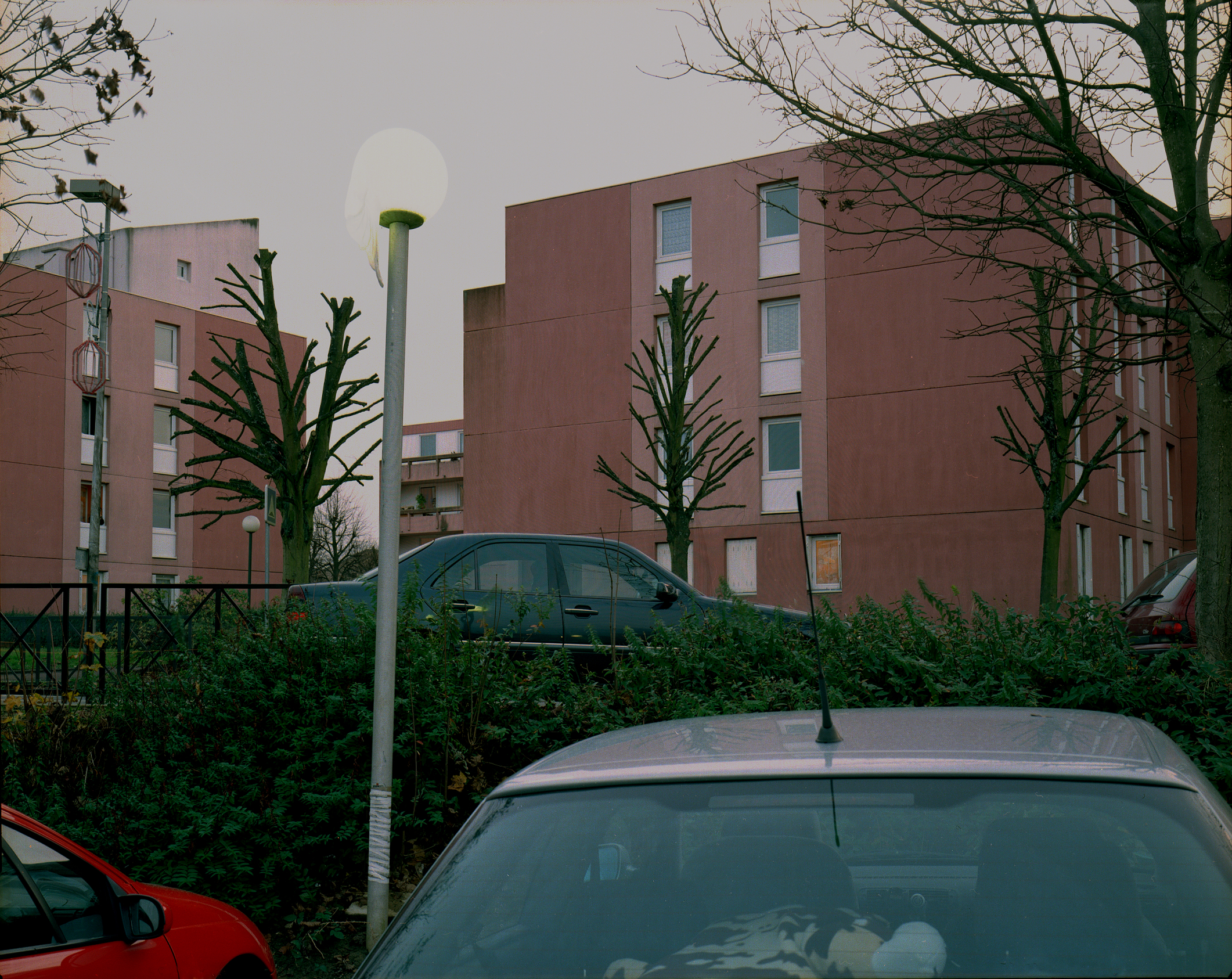
The sculptural installation »Trappes – ville nouvelle « consists of two cubes with horizontal and vertical drawers. They contain photographic views of residential districts, photographic portraits of inhabitants, social workers or city representatives, showing intergenerational relations and a large spectrum of social background, and « ballot papers », flyers, on which excerpts of conversations with residents and city workers or representatives are printed. The photographs and conversations are the result of a long term working process in the Parisian « satellite » town of Trappes, which was founded in the 1970s as an urban conglomeration of public sector housing projects.
NOTES ON THE WORK
Trappes was a railway city, before becoming the foundation of the Ville Nouvelle of St Quentin en Yveline (New City of St Quentin en Yveline) . It hosted its first « grands ensembles » (or large housing estates) in the 1960s. Then, between the 1970s and the beginning of the 1990s, when the planning of the New City as such started, it welcomed different types of « cité-jardins » (garden housing projects). These housings belong to many different social landlords. A policy of rehabilitation of these « grands ensembles » and squares started already in the mid 1990s.
The policy of attribution of this social housing (which carried the concentration of disadvantaged population in dormitory towns), added to serious mistakes concerning the urban coherence have created today a disfunctional urban situation and segregations. The new districts and the administrative area of Trappes are separated by a very busy national road; the new disctricts were supposed to surround the administrative centre, which was finally relocated; some social housings are located many kilometres away from commercial areas or from the administrative center; the social cultural centers aren’t visible and often hard to access. Grass roots, self-managed associations or initiatives are being replaced by professional state-runed associations, which are almost the only one to get bid sollicitations or supports by the city council. City policies react to security demands but are unable to consider a long term planning. The city seems neglected because of a lack of courage and motivation from politicians as well as from most of the social workers. This is accompanied by an inhabitants’ general lost of interest about their housings.
There is a so-called « social diversity » policy in Trappes which consists to develop individual housings through tenders. It also consists into the « residentialisation », on the equal distribution of social housings and access to private property. But« social diversity » policy remains a communication tools of a pragmatic unimaginative city policy, that has a hard time to resist the phenomenon of « ghettoization » and facing the lack of solidarity from the rich surrounding districts.
In these housing estates, there are often 2nd or 3rd generations of unemployed people. Paradoxically, the residents relate to their neighbourhood in a very strong affective way but at the same time they wish to go to live somewhere else, this « going away » being somehow an alternative to a depreciative and stigmatised vision of their neighbourhood. There seems to be an additional difficulty to give some value or sense to their housing experiences. The neighbourhoods are a temporary place, and simultaneously, they are a receptacle. They are marked by the memories of colonial history, by an immigration history being both shared and shattered. These neighbourhoods are also a present’s sensor (a ‘seismograph’) of a fragmented reality -the one from flashnews reports.
Trappes’ residents are stigmatized by the image of the « cité ». From the beginning of the 90’s Trappes has been occasionally at the media’s headlines, which are eager of burning news concerning the suburbs.
Trappes carries such media stigmatisation more heavily than other suburbs. Protocols, forms and knowledge are missing in order to produce information.
Locally, authorities keep on talking in schizophrenic manners about reinsertion through sports or work, about ghetto re-flowering.
After media and city politics, what is left of the reappropriation by the inhabitants of their self-representation? What about rethinking practices of everyday life? There is a need for a new articulation on collective living will, in order to rediscover autonomy and self-organization tools. How can art practices be defined in such a context?
Trappes, ville nouvelle
The municipal gallery from Trappes invited me to develop a work concerning the city. Such project began as a double commission: a commission from the gallery, and a commission towards myself. City politics often convey discourses of ‘social bonds’ and ‘social diversity’ in a positive and enthusiastic way. These discourses hide behind them the tensions and the political aspects of underlying conflicts. By applying these discourses’ iconography in a blind manner you can hardly escape from a propagandistic pitfall. My work « Trappes, A New City » tries to play with the limits of this political utopia of the ‘social bonds’. In order to extract and work with this iconography I needed to insufflate a burlesque dimension, to find some specific recording protocols and an exhibition form. The subject-matter of the city of Trappes becomes a microcosm. Burlesque causes tensions inside this reconstructed unity. These are both aesthetic and political tensions.
Interviews and images
I did a serie of interviews with residents such as a freshly arrived new resident, immigrant « pioneers » of the New City, old inhabitants who grew up at the time Trappes was still a railway city, city workers (social workers, City Council technicians, the historian of the city, the director of the City Museum of St-Quentin-en-Yveline) and in various local associations.
The photographic work consisted of portraits and still lifes, as well as one archive photograph. This photographic work came after the interviews. Some of these pictures show this « forced » closeness I decided to establish among inhabitants and city actors. Photographs showing a cart in a social centre, election billboards in a hangar, a hairdresser’s vitrine, or a streetlight, stand besides the archive photograph of a wagon’s framework hanging from an electric post after the 1944 bombing of a train depot. The choice of images came out of a corpusproduced over six months of work and out of the city archives.
The ballot boxes
The resulting is a body size, double, overlaid box of laminated wood. It is something between an archiving piece of furniture and an architectural element. The boxes contain a series of 26 front and back photographs and coloured boards set over horizontal and vertical runners, which can be manipulated by visitors. The double box is fixed over wheels enabling it to move easily over the space.
The ballot papers
Near at hand, printed colour papers evoking the colours of the boards containing collected interview excerpts going from a single word to a whole paragraph. These printings associate words and historical, mythological or autobiographical narratives, collective discussions and political discourses. The colored »ballot » papers suggest visitors to choose this word rather than another one, a word rather than a speech, a name rather than an anonymous text, and to link a photograph or a coloured board to it. Every person is invited to display the texts and to take them away.
A small sample of the ballot papers translated from french :
simply the recognition of the neighbour’s right
so, my career began like that: in strike
their appropriation
Some people never talk to their colleagues because they are scared that words could be repeated at the top. Some are not able to speak even if they are suffering. Some colleagues take antidepressants even if they never needed them before. They swallow them in the dinning hall. It’s better to open yourself up and to speak. They are under pressure.
« I go because we will be boumed », I couldn’t say “bombed” properly.
Mr Cordry : There were strikes during the Algerian war. Young people didn’t want to go there, we were used to strike often at that time. Some people chained themselves up when the Special Police came to embark them. There were daily trains going to Marseille or I don’t where, everyone tried to stop them. We always found a solution to keep them from going, or to pospone the departure of the wagons. We did everything to delay them. The government didn’t like it. They rushed the police into the depot towards us. Trade unionists didn’t like young people being sent over there, to be hit on the head in Algeria. Do you know what it means to hear bullets whistling? War isn’t funny for anyone.
Mme Cordry : Trappes was a real communists nest!
These are words that influence that person and make him understand he is not useful.
something like an experimental Smurfs’ village
We will tell everything that happened. When you tell, you feel better.
« Before, in 1972, there was still the tobacco shop and the Sonacotra worker’s housing in which the single workers used to live. I used to pick up people who were waiting for me at the bar of the workers housing and where people were drinking and having fun. Since few years, this workers housing, those cafés and bars have disappeared. If I have to pick up nowadays someone at the Mosque, then I think there is a big difference between waiting for someone in a Café or in a Mosque. » Mr Abassi
When my niece will go to the Mosque I will have no fear, because she won’t feel like a stranger, she will be able to speak French.
I had to do the cleaning and used new words
When we arrived and saw the school in the middle of the fields, I asked myself, why the hell did they put it here? Now I understand, I grasped that a long time ago when they built all around. Mme Cordry
(…)
Language of Production
FrenchTrappes, Ville Nouvelle


